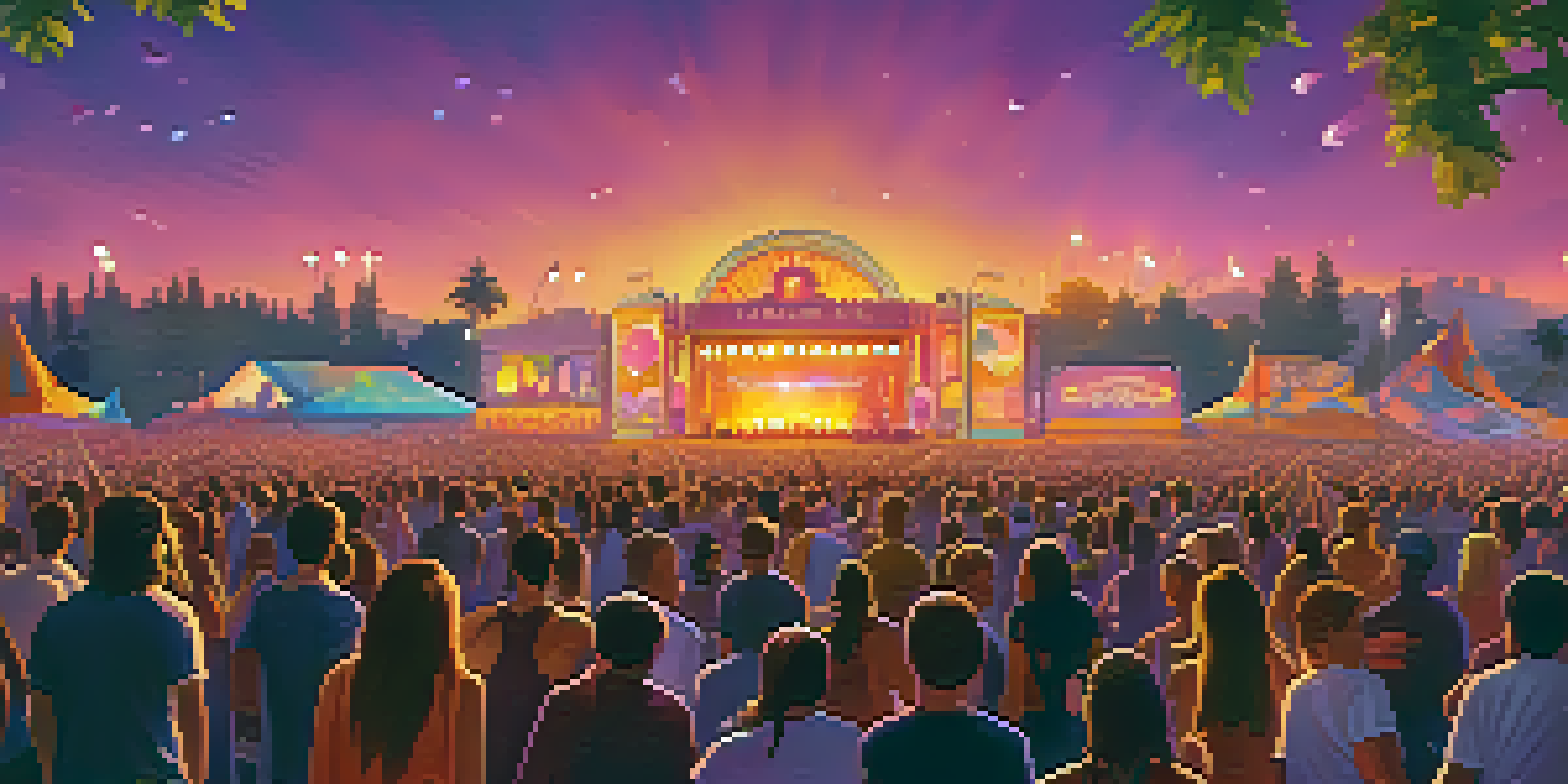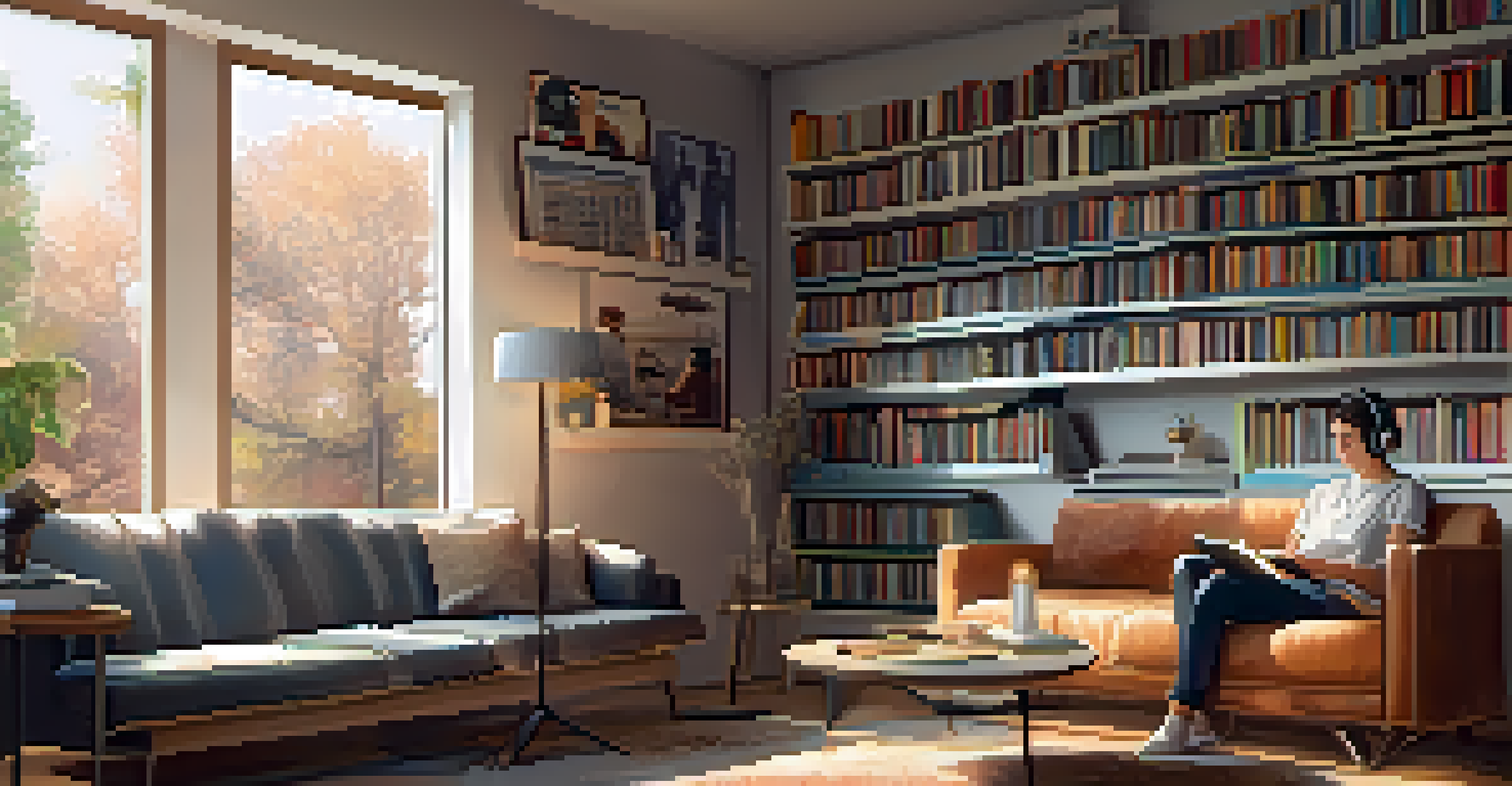How Soundtracks Shape Music Trends in Popular Culture Today

The Role of Soundtracks in Shaping Musical Preferences
Soundtracks play a pivotal role in shaping our musical tastes, often introducing us to new genres and artists. When a song from a movie or TV show resonates with viewers, it can spark a trend that transcends the screen. For instance, the success of the song "Shallow" from A Star is Born not only topped charts but also revived interest in ballads and duets.
Music can change the world because it can change people.
This influence is particularly evident among younger audiences, who often discover music through streaming platforms or playlists curated based on their favorite shows. The emotional connection fostered by soundtracks can create a lasting impact, leading listeners to explore more about the featured artists. Think of it as a modern-day mixtape, where the soundtrack serves as a gateway to broader musical exploration.
Moreover, as soundtracks become more accessible through platforms like Spotify, the lines between film, television, and music continue to blur. This integration enriches our cultural landscape, allowing soundtracks to be a driving force behind evolving music trends.
How Film and TV Choices Affect Music Genres
When examining music trends, it's essential to recognize how specific genres gain traction through their portrayal in films and television. For example, the surge in popularity of hip-hop can be attributed to its prominent features in blockbuster films and popular series. Shows like Atlanta and movies like Black Panther have showcased hip-hop culture, further cementing its influence on mainstream music.

As these genres become associated with high-profile media projects, they attract new audiences who may not have previously engaged with that style of music. This cross-pollination not only helps in popularizing diverse genres but also highlights the evolving nature of what is considered 'mainstream.' It's a fantastic reminder of how interconnected our entertainment choices are.
Soundtracks Shape Music Trends
Soundtracks introduce listeners to new genres and artists, acting as a gateway for musical exploration.
Consequently, music genres can experience resurgences based on their representation in soundtracks. The revival of retro sounds, like the 80s synthwave, can be traced back to a nostalgic wave in popular media, demonstrating how soundtracks can breathe new life into older musical styles.
The Emotional Connection of Soundtracks and Their Artists
Soundtracks create a unique emotional landscape that resonates deeply with audiences. When a specific song accompanies a pivotal scene, it can evoke powerful feelings that linger long after the credits roll. For instance, the haunting melody of "Time" by Hans Zimmer in Inception has become synonymous with moments of reflection, influencing listeners' emotional experiences.
Soundtracks are the heartbeat of a film, encapsulating emotions and connecting audiences to the narrative.
This emotional connection not only enhances the viewer's experience but also solidifies the artist's place in popular culture. Fans often associate their favorite moments with specific songs, leading to increased streams and sales for those tracks. It's as if the soundtrack becomes a part of the audience's personal narrative, further intertwining their memories with the music.
Moreover, this phenomenon can propel lesser-known artists into the spotlight, allowing them to reach wider audiences. A song that resonates emotionally in a film can lead to a surge in popularity for the artist, changing the trajectory of their career. It's a beautiful cycle where soundtracks elevate both the music and the emotions they convey.
The Impact of Streaming Services on Soundtrack Accessibility
With the rise of streaming services, soundtracks have become more accessible than ever. Listeners can easily find and enjoy their favorite tracks from films and shows, often curated into playlists on platforms like Spotify and Apple Music. This accessibility has transformed how we engage with music, allowing soundtracks to influence trends in real-time.
Moreover, streaming algorithms often recommend songs based on our listening habits, further amplifying the reach of soundtrack songs. If a certain track gains popularity due to its inclusion in a popular movie, it can quickly climb the charts, revealing the power of the digital age in music consumption. It's like having an endless playlist of your favorite moments at your fingertips.
Emotional Connections Drive Popularity
The emotional resonance of songs in film and TV enhances viewer experiences and boosts artists' visibility.
Consequently, this accessibility creates a feedback loop where audiences can instantly explore more about the artists behind the soundtracks. The ease of discovering and sharing music encourages cultural exchanges, promoting diversity in musical trends as listeners are introduced to various genres and styles.
How Viral Trends Originate from Popular Soundtracks
In the age of social media, soundtracks can ignite viral trends almost overnight. A catchy song featured in a popular TikTok video can lead to a surge in streams, often resulting in the track becoming a staple in popular culture. The viral nature of these platforms allows soundtracks to become part of larger trends, influencing everything from fashion to dance.
For example, the popularity of the song "Savage Love" by Jawsh 685 and Jason Derulo skyrocketed after being featured in numerous TikTok challenges. This showcases how soundtracks can propel songs into the mainstream, often transcending their original context. It's a fascinating dynamic where the audience plays an active role in the music's success.
This trend also highlights the importance of adaptability in the music industry. Artists and labels are increasingly aware of how soundtracks can create viral moments, leading to strategic partnerships with filmmakers and content creators. As a result, soundtracks are not just a backdrop; they are integral to shaping music trends in a rapidly changing cultural landscape.
The Cultural Significance of Soundtrack Diversity
Diversity in soundtracks reflects the rich tapestry of global music and culture. When films and shows feature a wide range of musical styles, they promote inclusivity and broaden audiences' musical horizons. For instance, the incorporation of Latin music in popular films like Coco has helped elevate artists like Carlos Vives and Rosalía, introducing them to new fans.
This cultural significance goes beyond entertainment; it challenges stereotypes and fosters a greater understanding of different cultures. When viewers engage with diverse soundtracks, they are more likely to explore the music and artists behind them. It's a wonderful opportunity for cultural exchange, where music becomes a bridge connecting various communities.
Diversity Promotes Cultural Exchange
Inclusive soundtracks reflect global music diversity, fostering understanding and appreciation of different cultures.
Moreover, as audiences demand representation in media, soundtracks play a crucial role in meeting that expectation. By showcasing a variety of genres and artists, soundtracks can help shape a more inclusive music landscape, encouraging a celebration of different voices and stories.
The Future of Soundtracks and Music Trends
Looking ahead, the role of soundtracks in shaping music trends is set to evolve further. As technology advances, we can expect innovative ways for soundtracks to engage audiences. Virtual reality and interactive storytelling could create immersive experiences where music plays a central role, inviting listeners to connect with soundtracks in unprecedented ways.
Moreover, the continued rise of independent films and series on streaming platforms provides opportunities for diverse soundtracks to flourish. This democratization of media allows a greater range of artists to be featured, potentially leading to the next big music trend emerging from unexpected places. It's an exciting time to be a music lover and a cinematic enthusiast.

Ultimately, soundtracks will remain a powerful force in the music industry, influencing trends and connecting people through shared experiences. As they continue to evolve, we can look forward to discovering new sounds and stories that resonate within our cultural landscape.